Analysis on Bearing Behavior of Single Pile under Combined Action of Vertical Load and Torque in Expansive Soil
Abstract
1. Introduction
2. Theoretical Derivation
2.1. The Ultimate Friction Resistance of the Pile Side
2.2. Solution of Piles under Single Vertical Load
2.2.1. Pile Displacement Caused by Soil Expansion
- ➢
- For the pile top, axial force can be written as:
- ➢
- For the pile tip, Wang et al. [7] proved that the pile tip and soil are separated after immersion through experiments. Hence, the force at the pile tip is expressed as follows:
- (i)
- Assign the vertical displacement vector of pile node to zero vector. The relative displacement of pile and soil is calculated. Then, the vertical stiffness matrix of the pile is obtained.
- (ii)
- Calculating displacement vector of pile node by Equation (16).
- (iii)
- A new vertical stiffness matrix is obtained using the new displacement vector , and a new node displacement is obtained using the new vertical stiffness matrix.
- (iv)
- Taking the maximum value of elements in the as iterative control error. If the error is greater than the limit value, repeat (ii)~(iv) until the iterative error is less than the limit value.
2.2.2. Nonlinear Solution of Single Pile under Vertical Load
- ➢
- For the pile top:
- ➢
- For the pile tip, the vertical bearing capacity can be expressed as:
- (i)
- Calculating the soil displacement around the pile after immersion and the vertical displacement vector of the pile caused by the uplift of the soil, then the pile–soil relative displacement is achieved.
- (ii)
- Solving the stiffness matrix of the pile under vertical loading, then the vertical displacement vectors of the pile nodes under vertical load can be calculated by the Equation (29).
- (iii)
- Based on the vertical displacement vectors , repeating steps (ii), then the vertical displacements update to be .
- (iv)
- Taking the maximum value of elements in as iterative control error. If the error is greater than the limit value, repeat (ii)~(iv) until the iterative error is less than the limit value.
2.3. Displacement Solution of Single Piles under V→T Loading Path
2.3.1. Determination of Circumferential Ultimate Frictional Resistance
2.3.2. Displacement Solution of Single Pile under V→T Loading Path
- (i)
- Calculating the vertical displacement of the pile element according to Section 2.2, then the relative displacement of the pile and soil can be obtained. Substituting it into the Equation (17), the vertical friction resistance can be obtained.
- (ii)
- The circumferential ultimate friction of the pile is achieved by solving Equation (32).
- (iii)
- Assign the pile node torsion angle vector to zero vector, the relative torsional displacement of the pile–soil at depth z is calculated. Then, the torque stiffness matrix is obtained.
- (iv)
- Calculating displacement vector of pile node by Equation (39).
- (v)
- A new torque stiffness matrix is obtained using the new torsion angle vector , and a new new torsion angle vector is obtained using the new vertical stiffness matrix.
- (vi)
- Taking the maximum value of elements in the as iterative control error. If the error is greater than the limit value, repeat (iii)~(vi) until the iterative error is less than the limit value.
3. Model Test
3.1. Model Pile
3.2. Test Soil
3.3. Loading and Measuring Device
3.4. Loading Scheme
4. Validation
4.1. Solution to the Internal Force of the Pile after Immersion
4.2. Nonlinear Solution of the Single Pile under Vertical Loading
4.3. Calculation of Single Pile Bearing Capacity under V→T Loading Path
5. Parametric Study
5.1. Bearing Capacity Envelope
5.2. Pile Deformation
5.3. The Effect of Expansion Rate on Bearing Capacity
6. Conclusions
Author Contributions
Funding
Institutional Review Board Statement
Informed Consent Statement
Data Availability Statement
Conflicts of Interest
References
- Shi, B.; Jiang, H.; Liu, Z.; Fang, H. Engineering geological characteristics of expansive soils in China. Eng. Geol. 2002, 67, 63–71. [Google Scholar] [CrossRef]
- Ministry of Housing and Urban-Rural Development of the People’s Republic of China. Technical Code for Buildings in Expansive Soil Regions; China Architecture and Building Press: Beijing, China, 2013. [Google Scholar]
- Ministry of Housing and Urban-Rural Development of the People’s Republic of China. Technical Code for Building Pile Foundations; China Architecture and Building Press: Beijing, China, 2008. [Google Scholar]
- Zou, X.J.; Xu, D.B.; Wang, Y.X. Analysis of Piles under H-M-T Combined Loading in Offshore Complex Environment. J. Disaster Prev. Mitig. Eng. 2014, 34, 736–741. [Google Scholar]
- Zou, X.J.; Wang, Y.X.; Xu, D.B. Bearing Capacity Analysis of V-T Combined Loaded Piles in Curved Girder Bridges. China J. Highw. Transp. 2015, 28, 51–58. [Google Scholar]
- Williams, A.B.B.; Donaldson, G. Building on expansive soils in South Africa. In Proceedings of the 4th International Conference Expansive Soils, Denver, Colorado, 16–18 June 1980; pp. 834–838. [Google Scholar]
- Wang, N.X.; Guo, R.W.; Zhang, W.M.; Gu, X.W. Model tests on behaviour of single pile in expansive soil. Chin. J. Geotech. Eng. 2008, 30, 56–60. [Google Scholar]
- Fan, Z.H. Research on Swelling-Shrinking Characteristic and Pile-Soil Interaction of Expansive Soil Foundation; Central South University: Changsha, China, 2007. [Google Scholar]
- Poulos, H.G.; Davis, E.H. Pile Foundation Analysis and Design; John Wiley & Sons: New York, NY, USA, 1980. [Google Scholar]
- Soundara, B.; Robinson, R.G. Hyperbolic model to evaluate uplift force on pile in expansive soils. KSCE J. Civ. Eng. 2017, 21, 746–751. [Google Scholar] [CrossRef]
- Zhang, D.F.; Yang, J.; Li, L.Y.; Shen, Z.P. Analytical solutions of pile–soil interaction in expansive soil foundation with expansion rate and stiffness variation along the depth. Eng. Mech. 2016, 33, 86–93. [Google Scholar]
- Xiao, H.B.; Zhang, C.S.; Wang, Y.H.; Fan, Z.H. Pile-Soil Interaction in Expansive Soil Foundation: Analytical Solution and Numerical Simulation. Int. J. Géoméch. 2011, 11, 159–166. [Google Scholar] [CrossRef]
- Liu, Y.; Vanapalli, S.K. Load displacement analysis of a single pile in an unsaturated expansive soil. Comput. Geotech. 2019, 106, 83–98. [Google Scholar] [CrossRef]
- Georgiadis, M. Interaction between torsional and axial pile responses. Int. J. Numer. Anal. Methods Geomech. 1987, 11, 645–650. [Google Scholar] [CrossRef]
- Georgiadis, M.; Saflekou, S. Piles under axial and torsional loads. Comput. Geotech. 1990, 9, 291–305. [Google Scholar] [CrossRef]
- Fan, Q.L.; Meng, X.B. Failure envelope of pipe pile foundation under combined loading. In Advances in Pile Foundations, Geosynthetics, Geoinvestigations, and Foundation Failure Analysis and Repairs; ASCE: Reston, VA, USA, 2011; pp. 109–115. [Google Scholar]
- Wang, S.W.; Jiang, J.; Fu, C.Z.; Ou, X.D.; Tang, J. Analysis of the Bearing Characteristics of Single Piles under Vertical and Torsional Combined Loads. Adv. Civ. Eng. 2021, 2021, 8896673. [Google Scholar] [CrossRef]
- Nelson, J.D.; Chao, K.C.G.; Overton, D.D.; Nelson, E.J. Foundation Engineering for Expansive Soils; Wiley: Hoboken, NJ, USA, 2015. [Google Scholar]
- Potyondy, J.G. Skin Friction between Various Soils and Construction Materials. Géotechnique 1961, 11, 339–353. [Google Scholar] [CrossRef]
- Kraft, L.M.; Ray, R.P.; Kagawa, T.T. Theoretical t-z curves. J. Geotech. Eng. Div. 1981, 107, 1543–1561. [Google Scholar] [CrossRef]
- Alonso, E.E.; Josa, A.; Ledesma, A. Negative skin friction on piles: A simplified analysis and prediction procedure. Géotechnique 1984, 34, 341–357. [Google Scholar] [CrossRef]
- Comodromos, E.M.; Anagnostopoulos, C.T.; Georgiadis, M.K. Numerical assessment of axial pile group response based on load test. Comput. Geotech. 2003, 30, 505–515. [Google Scholar] [CrossRef]
- Randolph, M.; Wroth, C.P. Analysis of deformation of vertically loaded piles. J. Geotech. Eng. Div. ASCE 1978, 104, 1465–1488. [Google Scholar] [CrossRef]
- Mylonakis, G.; Gazetas, G. Settlement and additional internal forces of grouped piles in layered soil. Géotechnique 1998, 48, 55–72. [Google Scholar] [CrossRef]
- Li, G.X.; Zhang, B.Y.; Yu, Y.Z. Soil Mechanics, 2nd ed.; Tsinghua University Press: Beijing, China, 2013. [Google Scholar]
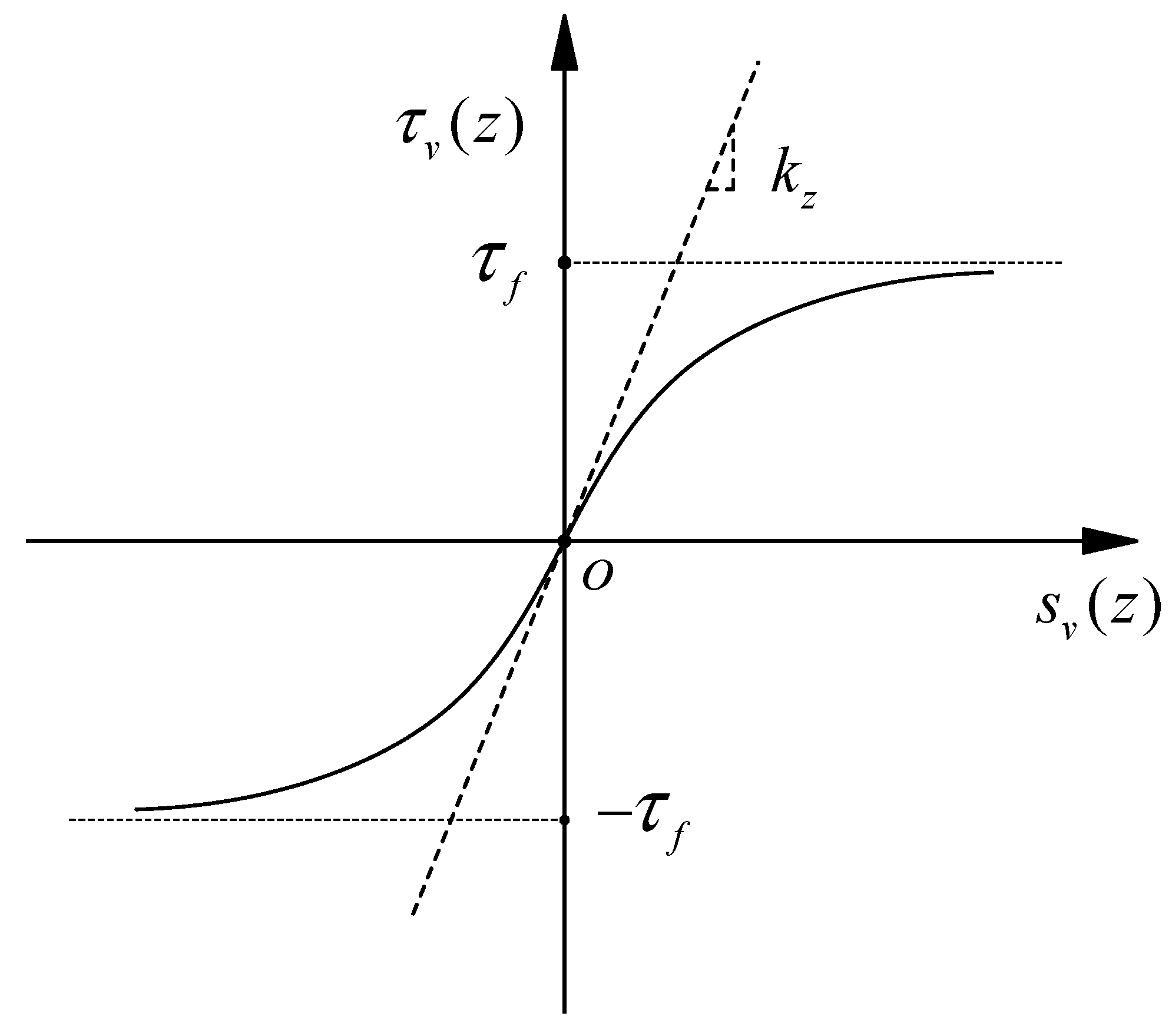

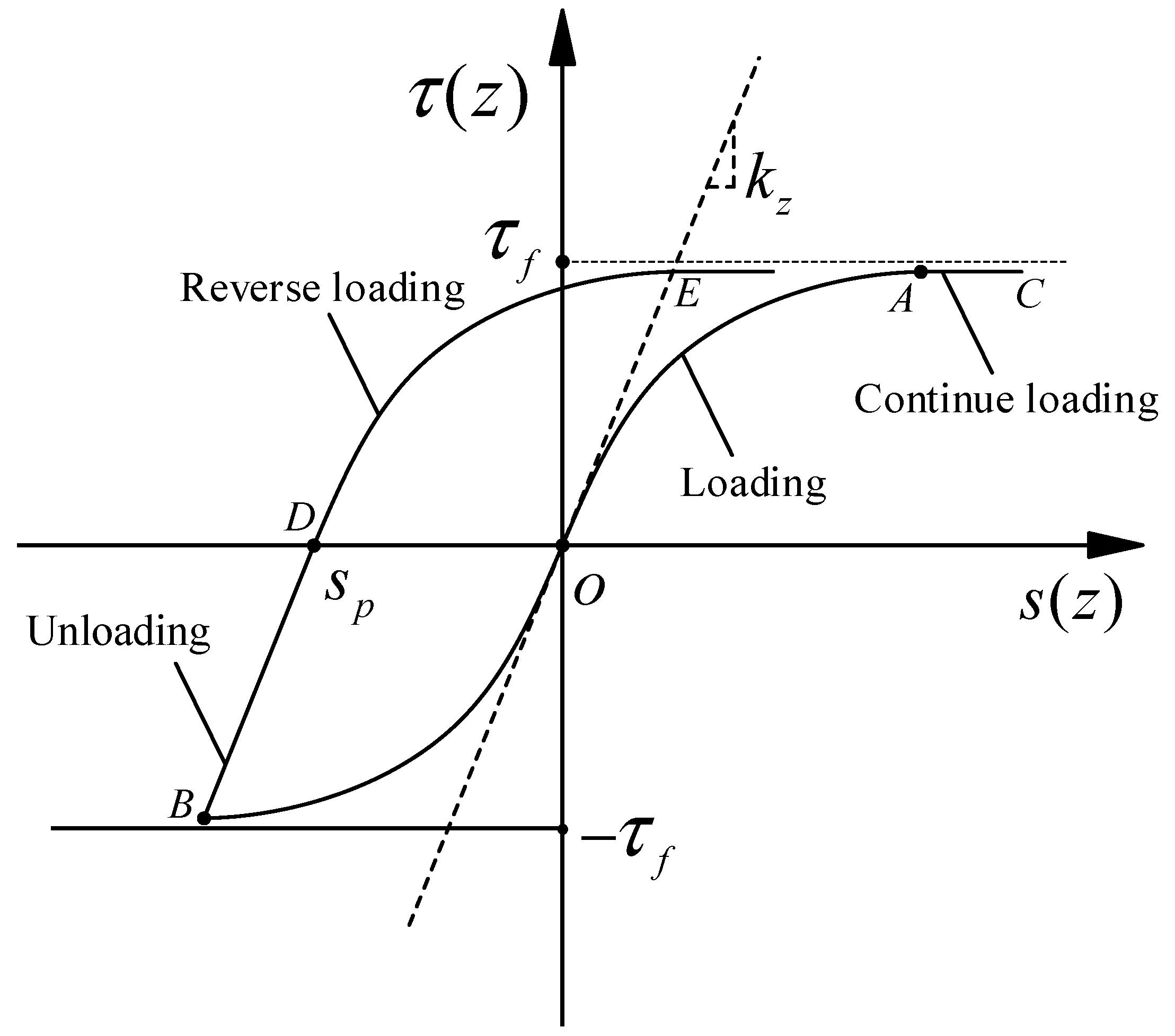

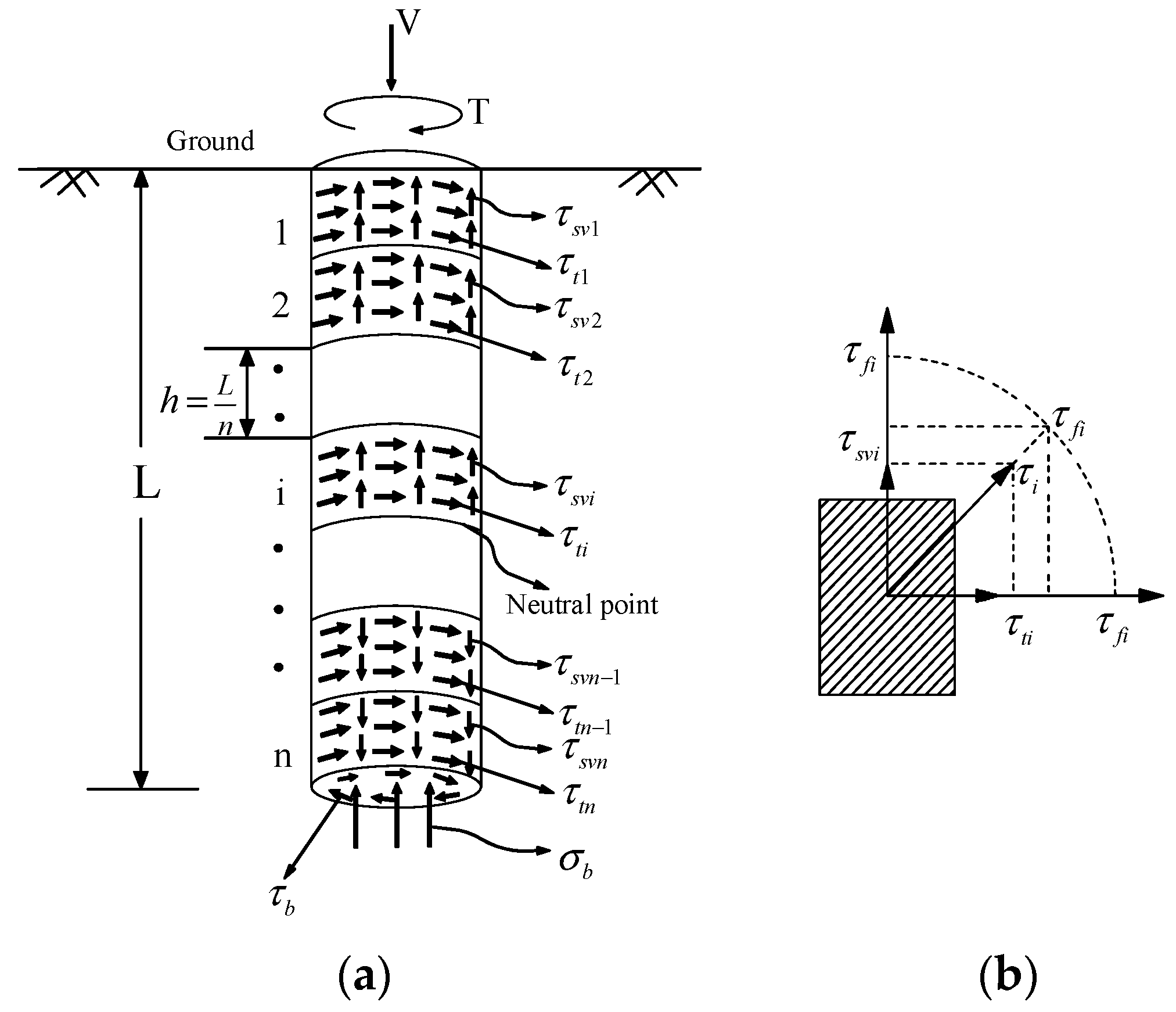
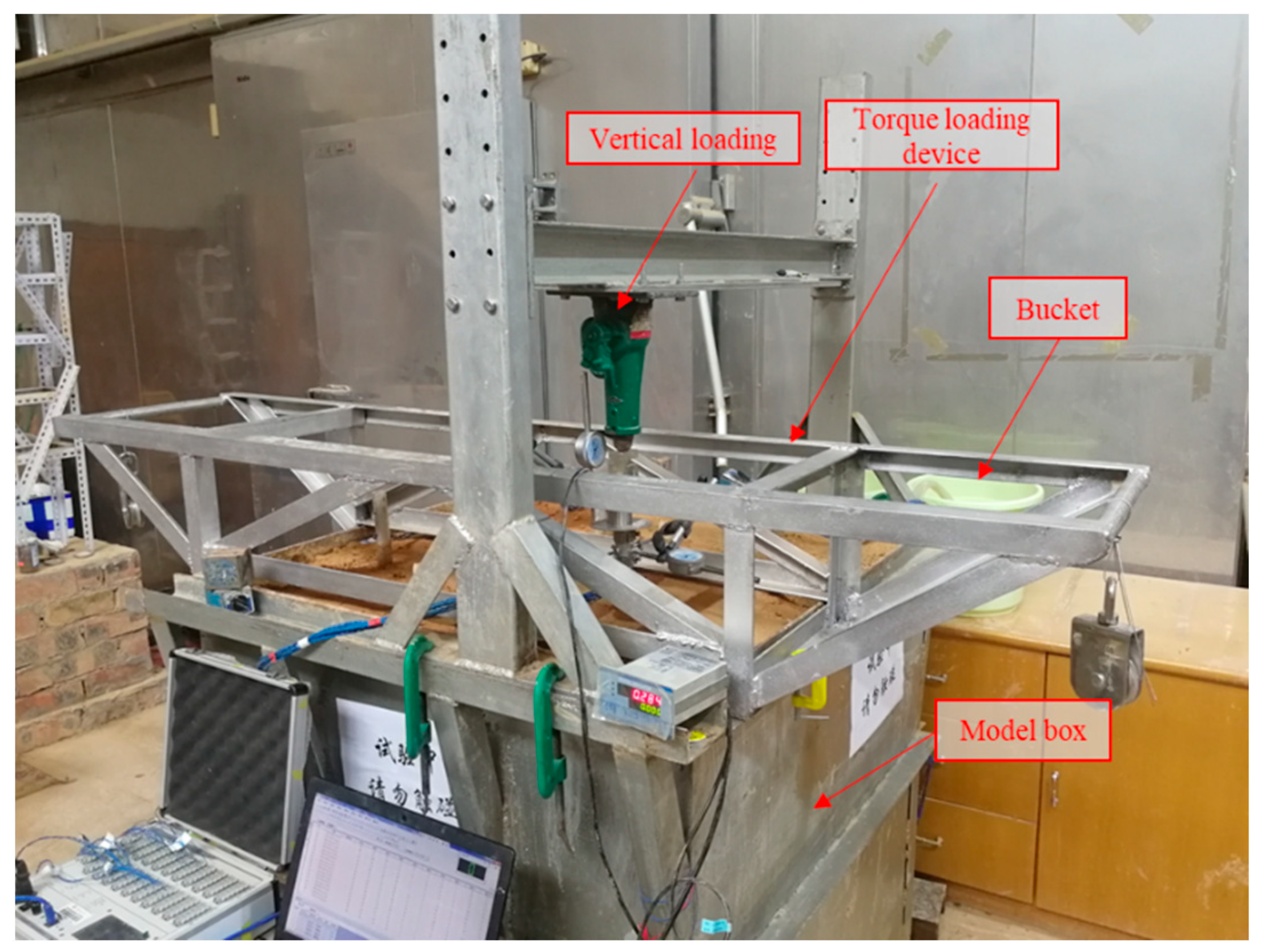
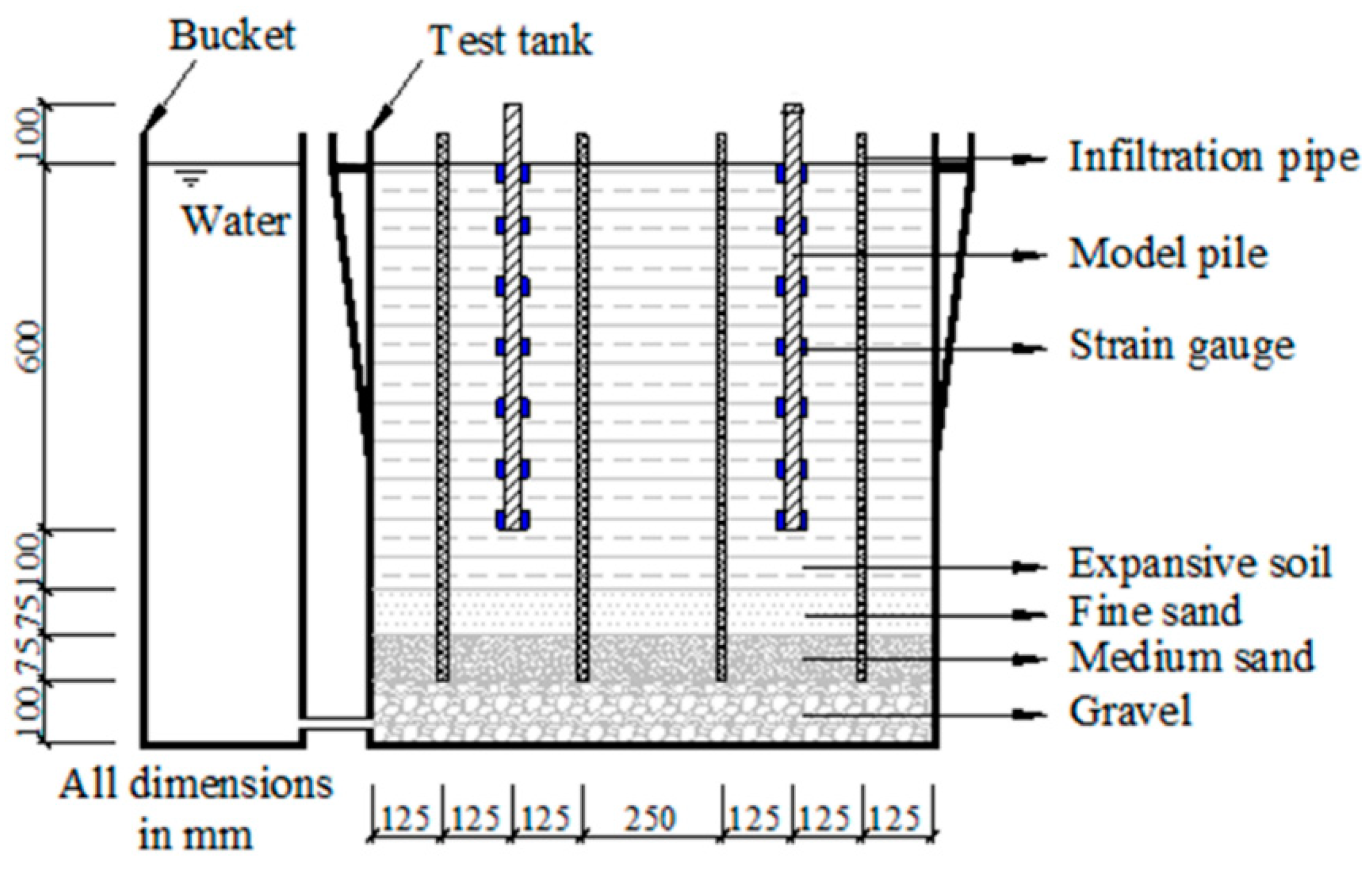
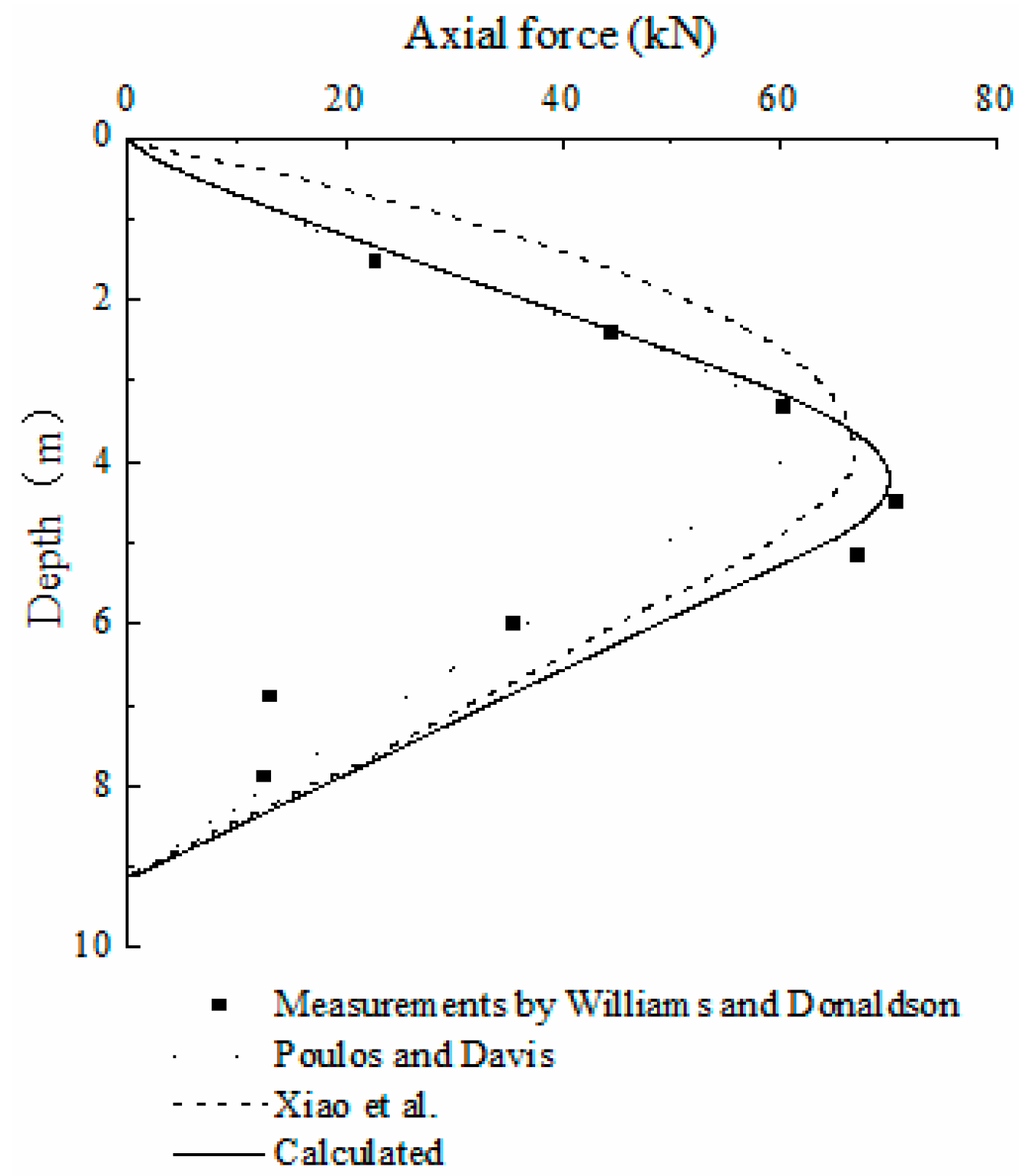
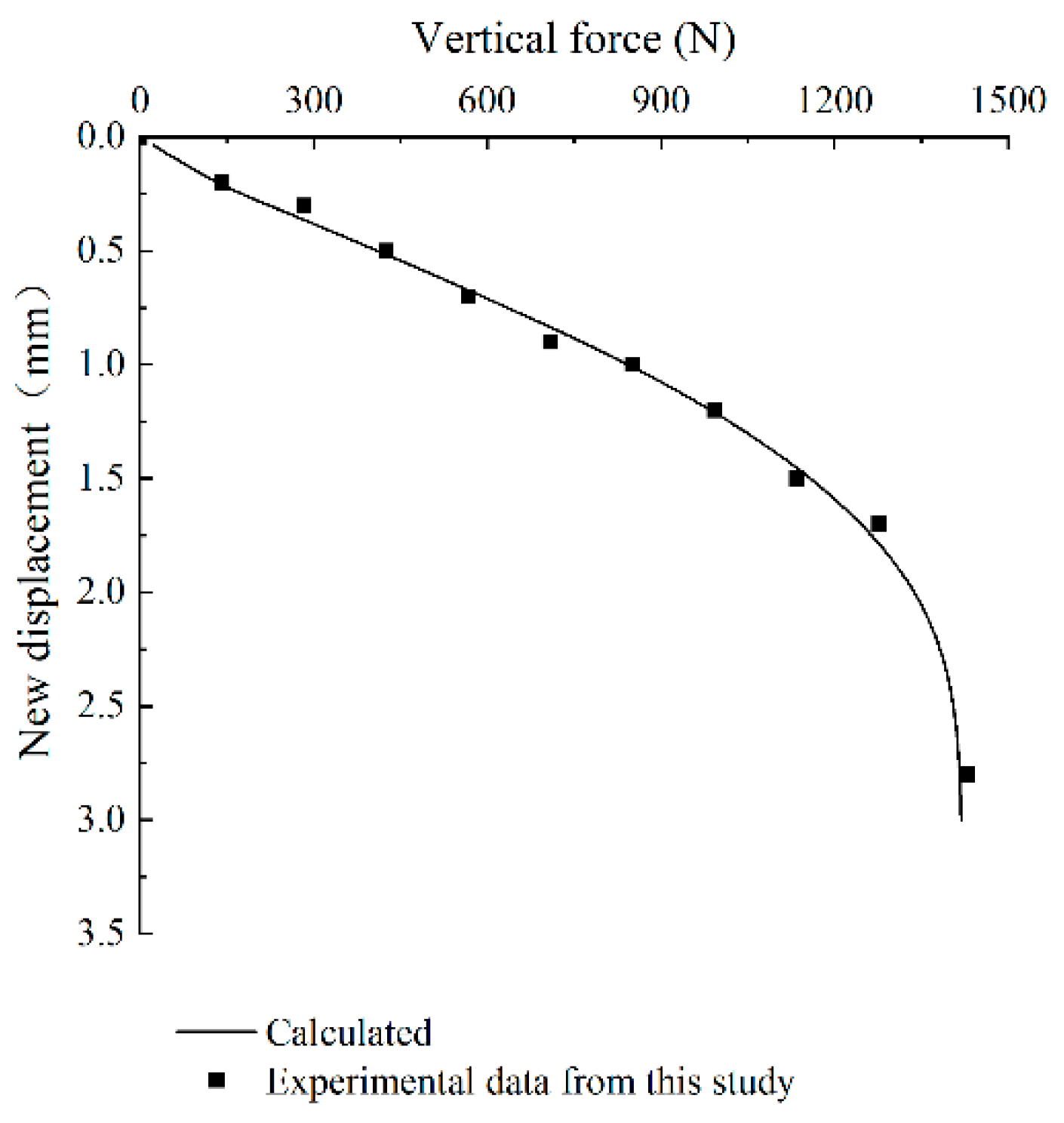
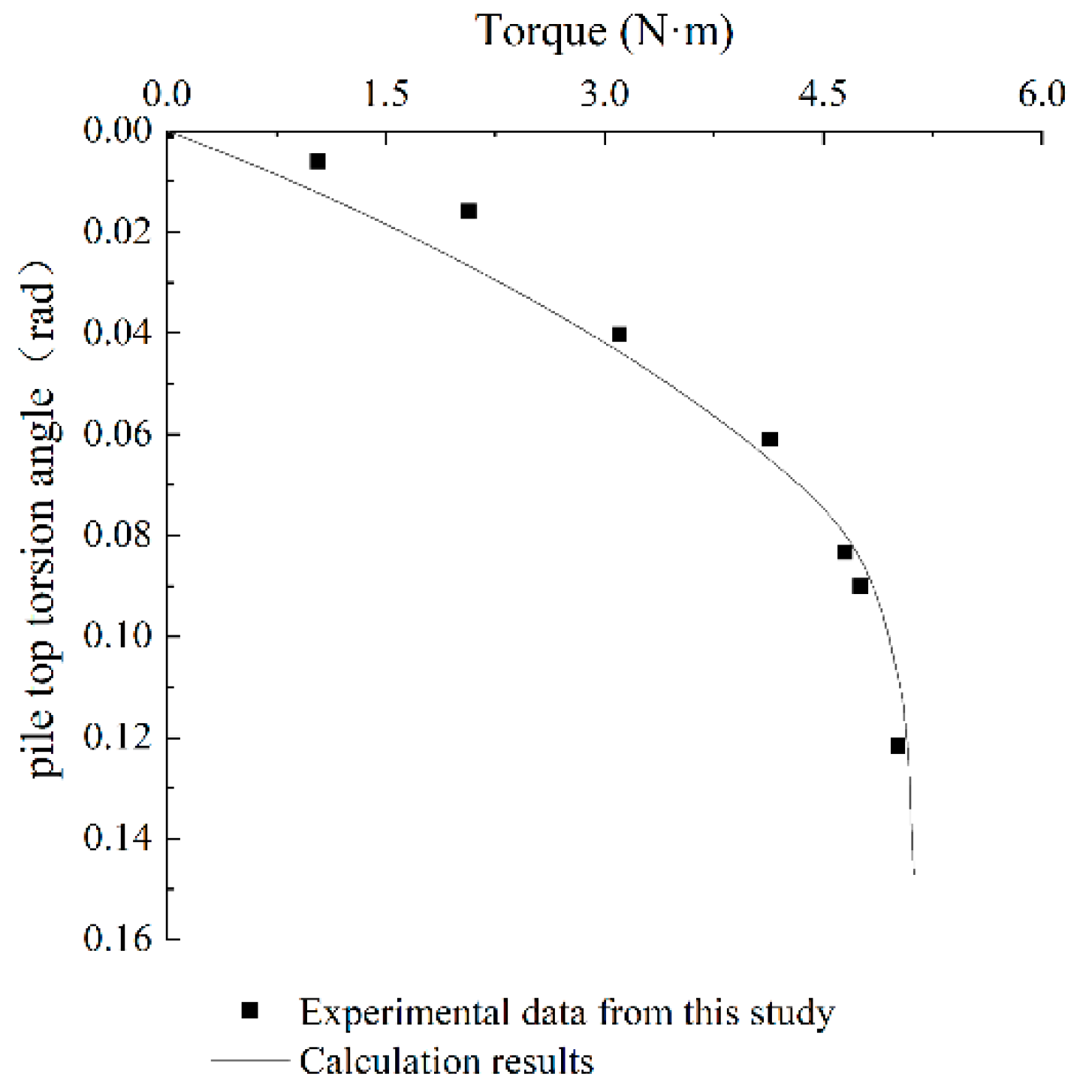

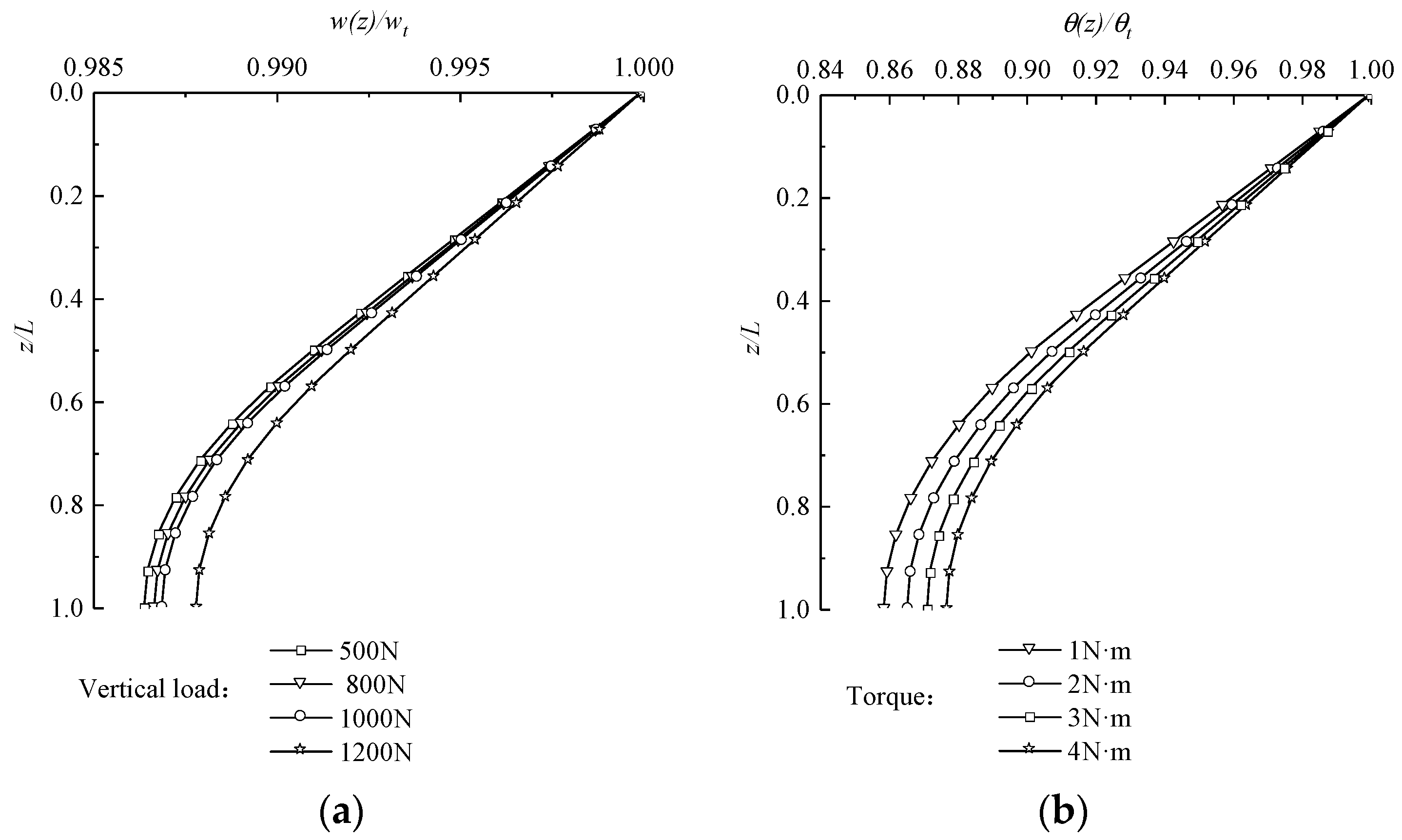
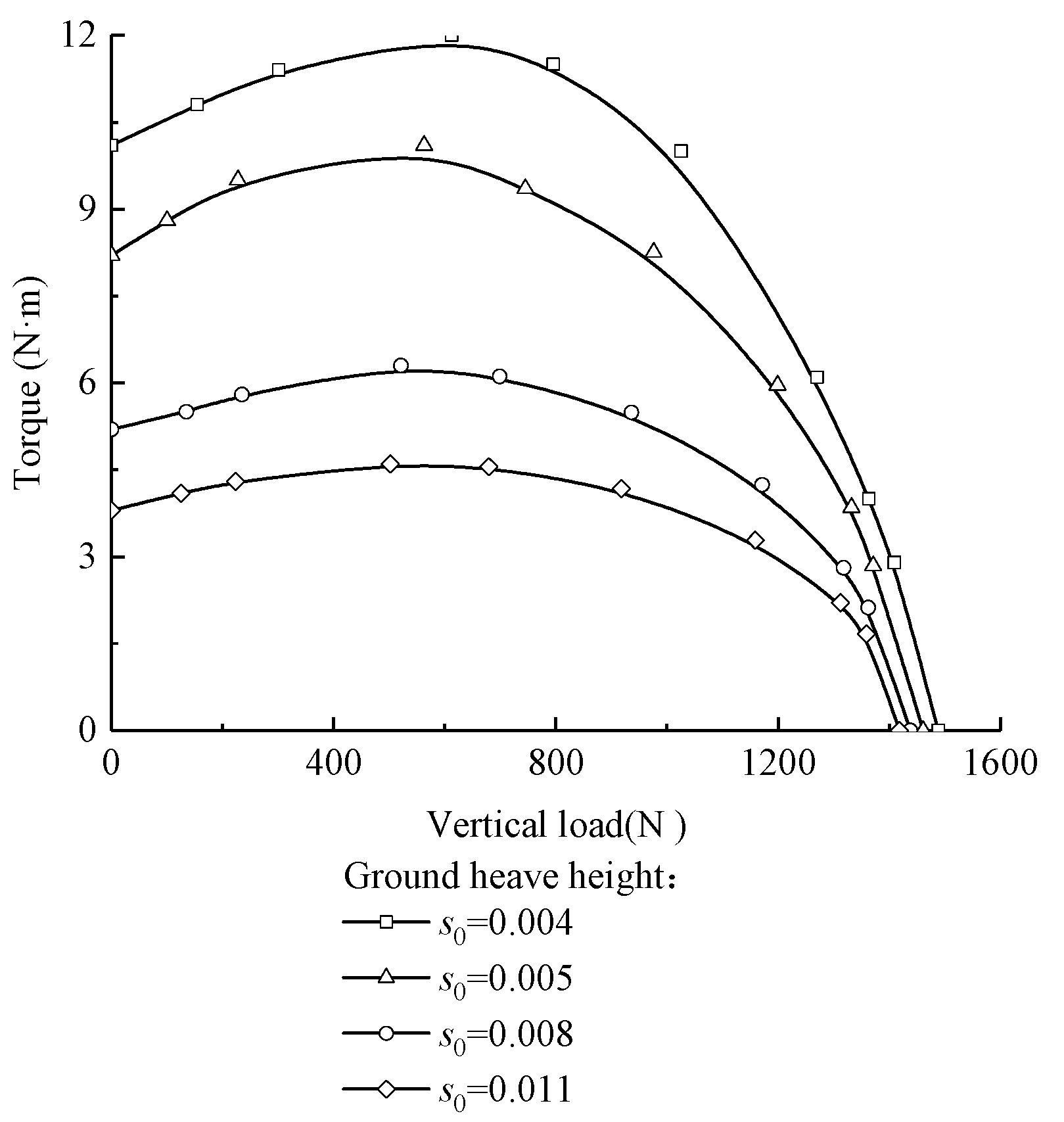
| State | Density (g/cm3) | Cohesion (kPa) | Internal Friction (°) |
|---|---|---|---|
| Before immersion | 1.92 | 39.6 | 18 |
| After immersion | 2.19 | 23.7 | 17.6 |
| Group | Serial Number | Vertical Load (V) | Torsional Load (T) | ||
|---|---|---|---|---|---|
| Value | Ways of Loading | Value | Ways of Loading | ||
| 1 | P1 | Vu | Step loading | / | / |
| 2 | P2 | 0 | / | Tu1 | Step loading |
| P3 | Vu/6 | Constant | Tu2 | Step loading | |
| P4 | Vu/3 | Constant | Tu3 | Step loading | |
| P5 | Vu/2 | Constant | Tu4 | Step loading | |
| P6 | 2Vu/3 | Constant | Tu5 | Step loading | |
Disclaimer/Publisher’s Note: The statements, opinions and data contained in all publications are solely those of the individual author(s) and contributor(s) and not of MDPI and/or the editor(s). MDPI and/or the editor(s) disclaim responsibility for any injury to people or property resulting from any ideas, methods, instructions or products referred to in the content. |
© 2023 by the authors. Licensee MDPI, Basel, Switzerland. This article is an open access article distributed under the terms and conditions of the Creative Commons Attribution (CC BY) license (https://creativecommons.org/licenses/by/4.0/).
Share and Cite
Wang, Z.; Jiang, J.; Wang, S.; Fu, C.; Yang, D. Analysis on Bearing Behavior of Single Pile under Combined Action of Vertical Load and Torque in Expansive Soil. Appl. Sci. 2023, 13, 4133. https://doi.org/10.3390/app13074133
Wang Z, Jiang J, Wang S, Fu C, Yang D. Analysis on Bearing Behavior of Single Pile under Combined Action of Vertical Load and Torque in Expansive Soil. Applied Sciences. 2023; 13(7):4133. https://doi.org/10.3390/app13074133
Chicago/Turabian StyleWang, Zhi, Jie Jiang, Shunwei Wang, Chenzhi Fu, and Di Yang. 2023. "Analysis on Bearing Behavior of Single Pile under Combined Action of Vertical Load and Torque in Expansive Soil" Applied Sciences 13, no. 7: 4133. https://doi.org/10.3390/app13074133
APA StyleWang, Z., Jiang, J., Wang, S., Fu, C., & Yang, D. (2023). Analysis on Bearing Behavior of Single Pile under Combined Action of Vertical Load and Torque in Expansive Soil. Applied Sciences, 13(7), 4133. https://doi.org/10.3390/app13074133






